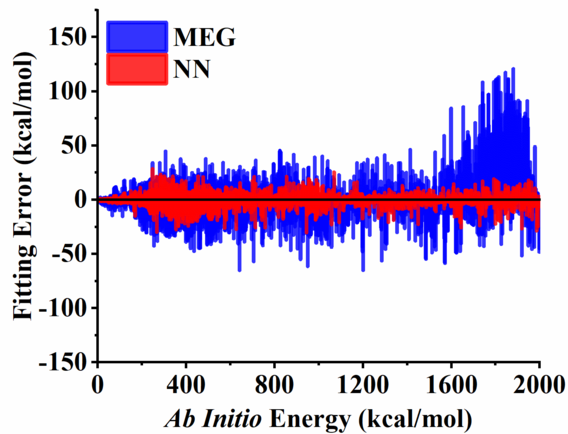The potential energy surface for high energy N2–N2 collisions was originally [1] fit by moving least squares [1] and by conventional linear regression [2]. Now, in collaboration with Jun Li of Chongqing University and Hua Guo of the University of New Mexico, we have revisited this problem using machine learning, in particular using a neural network (NN) for the fit [3]. Due to the requirement of very complete data coverage of the geometric domain in order to get a physical fit by NN, the number of points in original fitting dataset was extended by about 30% to get 21 406 points. We used several tactical steps to achieve reasonably good data coverage. For the same input data, the NN fit is more accurate than a linear regression fit (denoted MEG in the figure), although using it for trajectory studies is more expensive.
[1] “Potential Energy Surface Fitting by a Statistically Localized, Permutationally Invariant, Local Interpolating Moving Least Squares Method for the Many-Body Potential: Method and Application to N4,” J. D. Bender, S. Doraiswamy, D. G. Truhlar, and G. V. Candler, Journal of Chemical Physics 140, article 054302 (2014). doi.org/10.1063/1.4862157
[2] “An Improved Potential Energy Surface and Multi-Temperature Quasiclassical Trajectory Calculations of N2 + N2 Dissociation Reactions,” J. Bender, P. Valentini, I. Nompelis, Y. Paukku, Z. Varga, D. G. Truhlar, T. Schwartzentruber, and G. Candler, Journal of Chemical Physics 143, article 054304 (2015). doi.org/10.1063/1.4927571
[3] “Many-Body Permutationally-Invariant-Polynomial Neural-Network Potential Energy Surface for N4,” J. Li, Z. Varga, D. G. Truhlar, and H. Guo, Journal of Chemical Theory and Computation 16, 4822-4832 (2020). doi.org/10.1021/acs.jctc.0c00430
